April
M. Boulton
Island
Biology & Soil Ecology

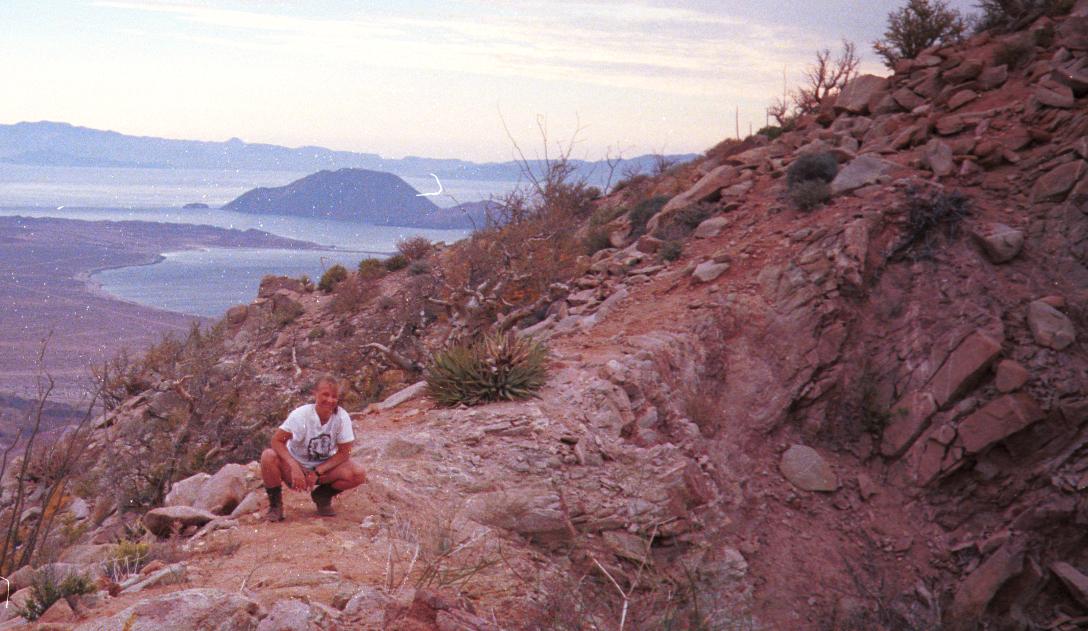
Environmental Science and Policy
2132 Wickson Hall
University of California
Davis, CA 95616
TEL: (530) 661-4104
amboulton@ucdavis.edu

 ANTS &
SOIL FOODWEBS
ANTS &
SOIL FOODWEBS
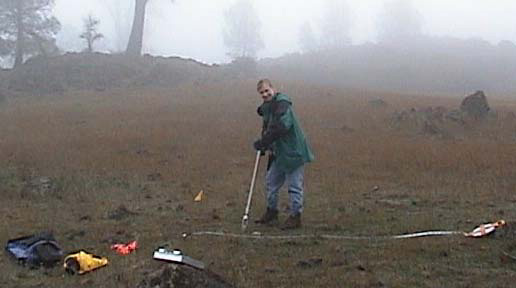
|
|
Coring soil from
ant nests at McLaughlin Reserve in northern California
|
I am examining the effect of harvester ants
on soil foodwebs in northern California serpentine. Specifically,
I am studying how these ants structure belowground foodwebs by transporting
massive amounts of aboveground productivity below the soil’s surface.
Soil foodwebs are central to the processing of organic matter and control
much of the spatio-temporal distribution of water and nutrients.
Thus, any organism affecting the diversity and abundance of soil biota
will play an integral role in ecosystem integrity. In one study,
I compared soil biota and
chemistry between harvester ant (Messor andrei) nests and adjacent,
non-ant soil from a semi-arid, serpentine grassland. The major soil
groups were examined, namely bacteria, fungi, nematodes, miscellaneous eukaryotes,
and microarthropods (e.g., mites and collembolans). Bacteria, fungi,
and other eukaryotes were identified using the culture-independent method,
phospholipid fatty acid analysis (PLFA). All soil groups were more
abundant and diverse in ant nests than in non-ant soil, and all soil nutrients
were similarly enriched inside nests. A principal component analysis
indicated that the enrichment of bacteria and fungi inside ant nests explains
the majority of variation in the other response variables. Thus, it
appears that M. andrei performs some activity and/or enriches one
or more nutrients (e.g., phosphorous), which heavily impacts the base of
the soil foodweb (bacteria and fungi). This suggests that these ant
nests effect a form of bottom-up control in the resident soil biota.
In the next study, I examined
the mechanism behind this "ant effect" using a field experiment. I
replaced local soil cores inside M. andrei nests and in four adjacent
cores (N nests = 10). The four cores outside the ant nest were
treated with one of four conditions (i.e., 2 X 2 factorial design with
water and food additions as the two independent variables). The
results were complex, but the two treatments with food additions most closely
resembled ant nest soils for soil biota and chemistry. Thus, I have
initial evidence suggesting that the "ant effect" is produced largely via
ant deposition of organic matter into their nest and surrounding soil.

 ANTS
ON ISLANDS
ANTS
ON ISLANDS
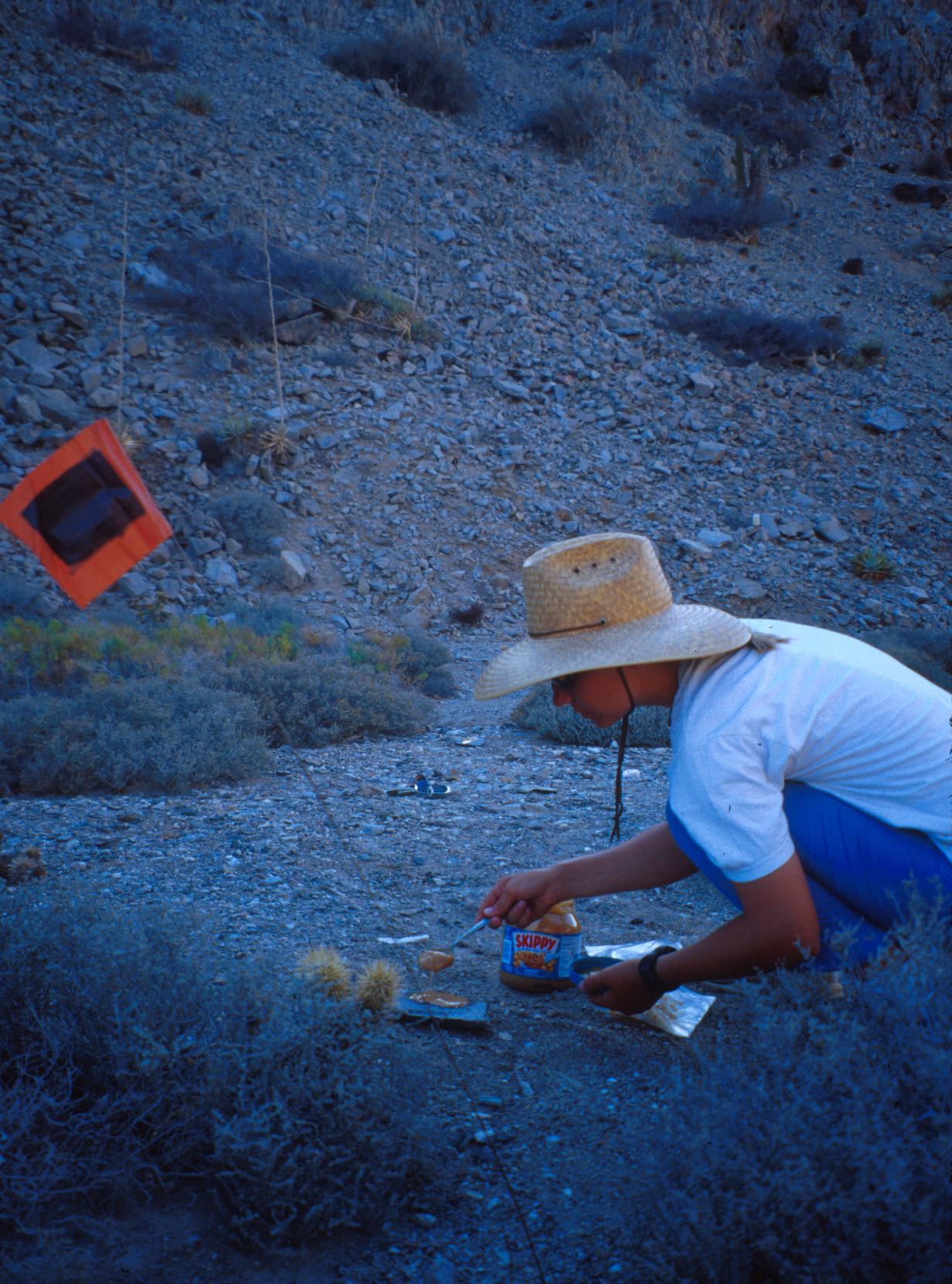
|
|
Baiting with peanut
butter in order to attract ants
|
I conducted a classical island biogeographic
study of the ant fauna in the Sea of Cortez (with a lot of ID-help
from Dr. Phil Ward). This work will soon appear in Case and Cody's
second edition of their well received book, "Island Biogeography in the
Sea of Cortez." In short, I have found that ant species number
varies as a function of island area (not isolation, sea depth or any
other abiotic factor measured). In addition, ant species number
is negatively associated with seabird presence, and plant cover does not
affect ant richness.
Boulton, A. M. & Ward, P. S. In press for 2003. Island
biogeography of ants in the Sea of Cortez. In Case & Cody,
eds. Island Biogeography of the Sea of Cortez, 2nd ed. University
of California Press: Berkeley & Los Angeles

 SPIDERS
ON ISLANDS
SPIDERS
ON ISLANDS
GENETIC STRUCTURE IN A COASTAL DUNE SPIDER (GEOLYCOSA PIKEI)
ON LONG ISLAND, NEW YORK BARRIER ISLANDS
Formed some 8,000 years ago, inlets, sea-level rise, and human activities
have fragmented most of the linear Long Island barrier islands making
them ideal areas for testing the stepping-stone population model in
a sedentary spider, Geolycosa pikei. Ten isolated populations
collected from the barriers were analyzed via allozyme electrophoresis
to estimate gene frequencies at 12 loci. Only four loci were polymorphic
(i.e., AAT, APK, GPI, IDH-1), and populations showed little differentiation
(mean FST = 0.020). Contrary to stepping-stone model predictions, the matrix
of genetic distances among sites was not significantly associated with the
physical distance matrix, which suggests that G. pikei on Long Island
barriers does not adhere to a stepping-stone model. Geolycosa pikei
may be better dispersers than previously estimated and/or the ephemeral
quality of the inlets may not allow for the development of significant inter-populational
genetic differences. In addition, geologic evidence suggests that these
barriers became relatively stable only 8,000 B. P. Therefore, these habitats
have been only recently colonized, which may result in low genetic variability
and inter-populational differentiation possibly due to genetic drift
from repeated and prolonged bottlenecks during recolonization (i.e., founder
events).
Boulton, A. M., Ramirez, M. G. & Blair,
C. 1997. Genetic structure of a coastal dune spider (Geolycosa pikei
) on Long Island, New York barrier islands. Biological Journal
of the Linnean Society 60: 69-82.
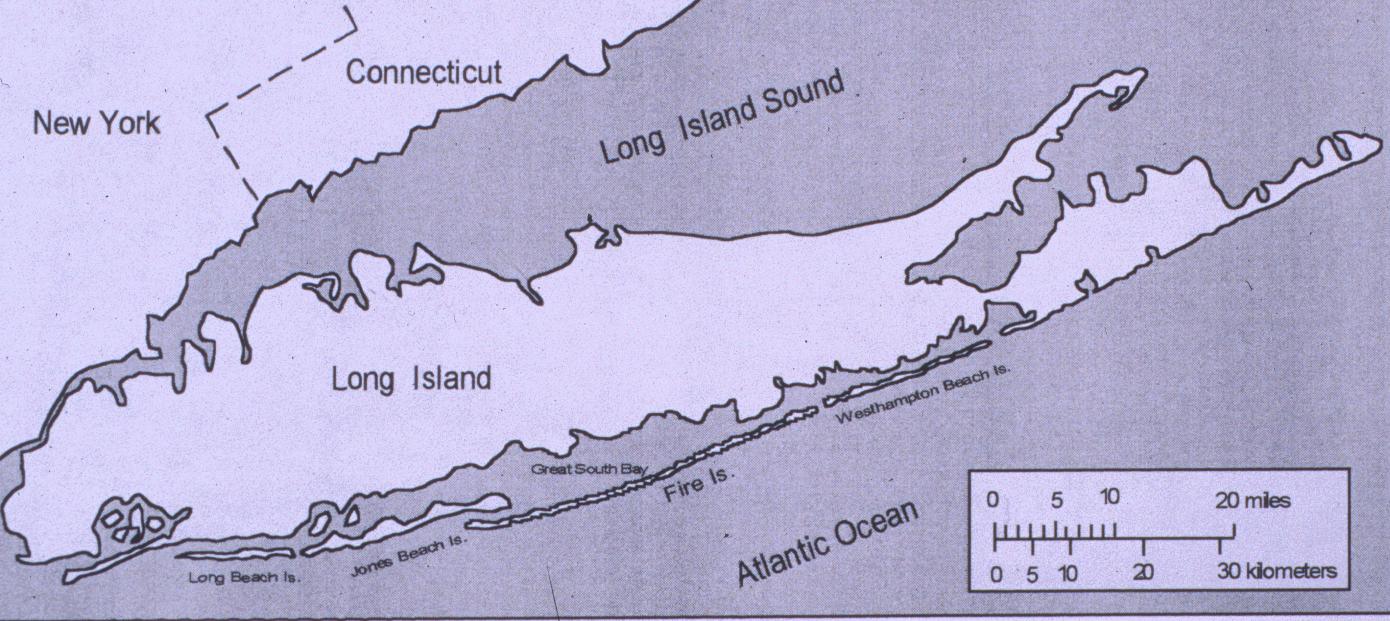
|
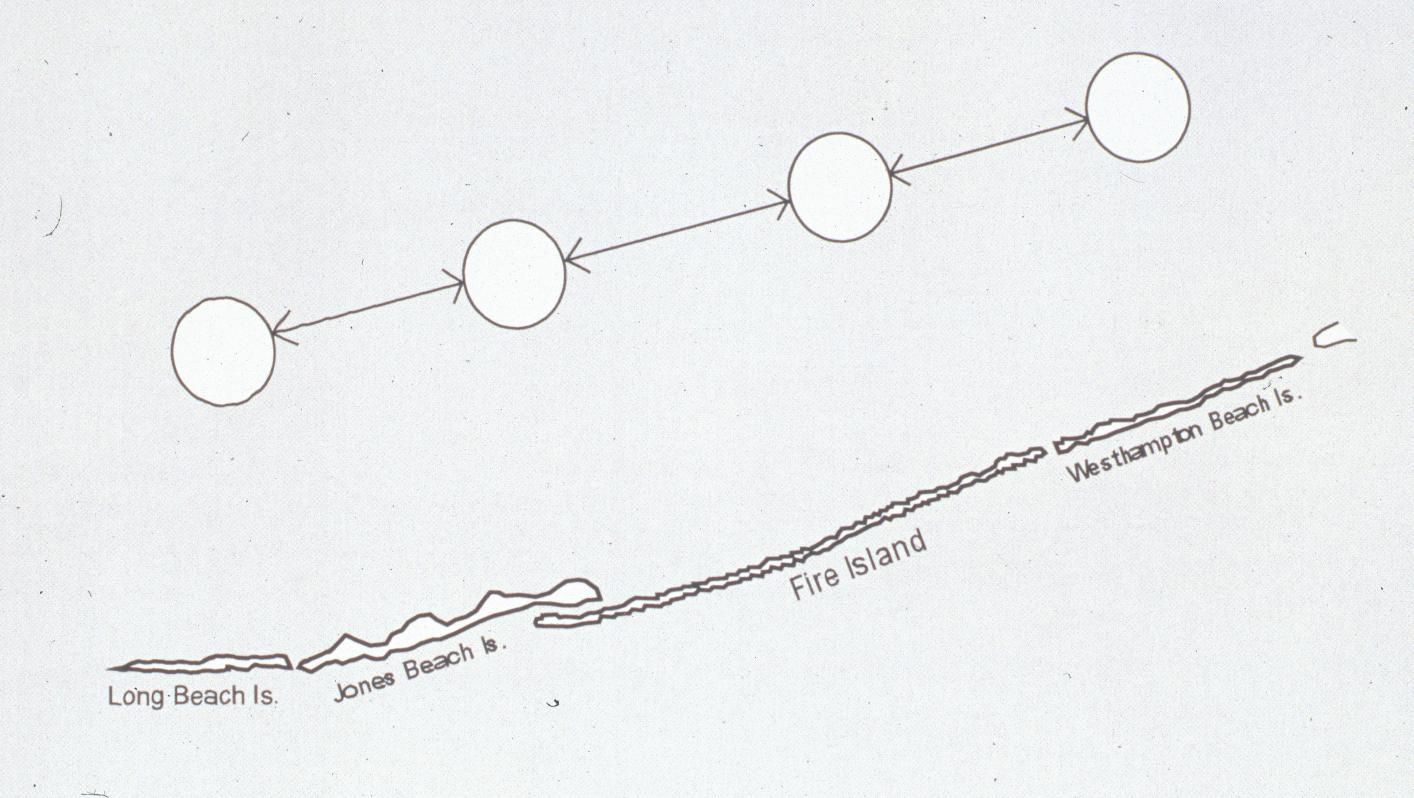
|
|
Long Island, New
York
|
Barrier Islands off Long Island, NY resemble a stepping-stone model
|
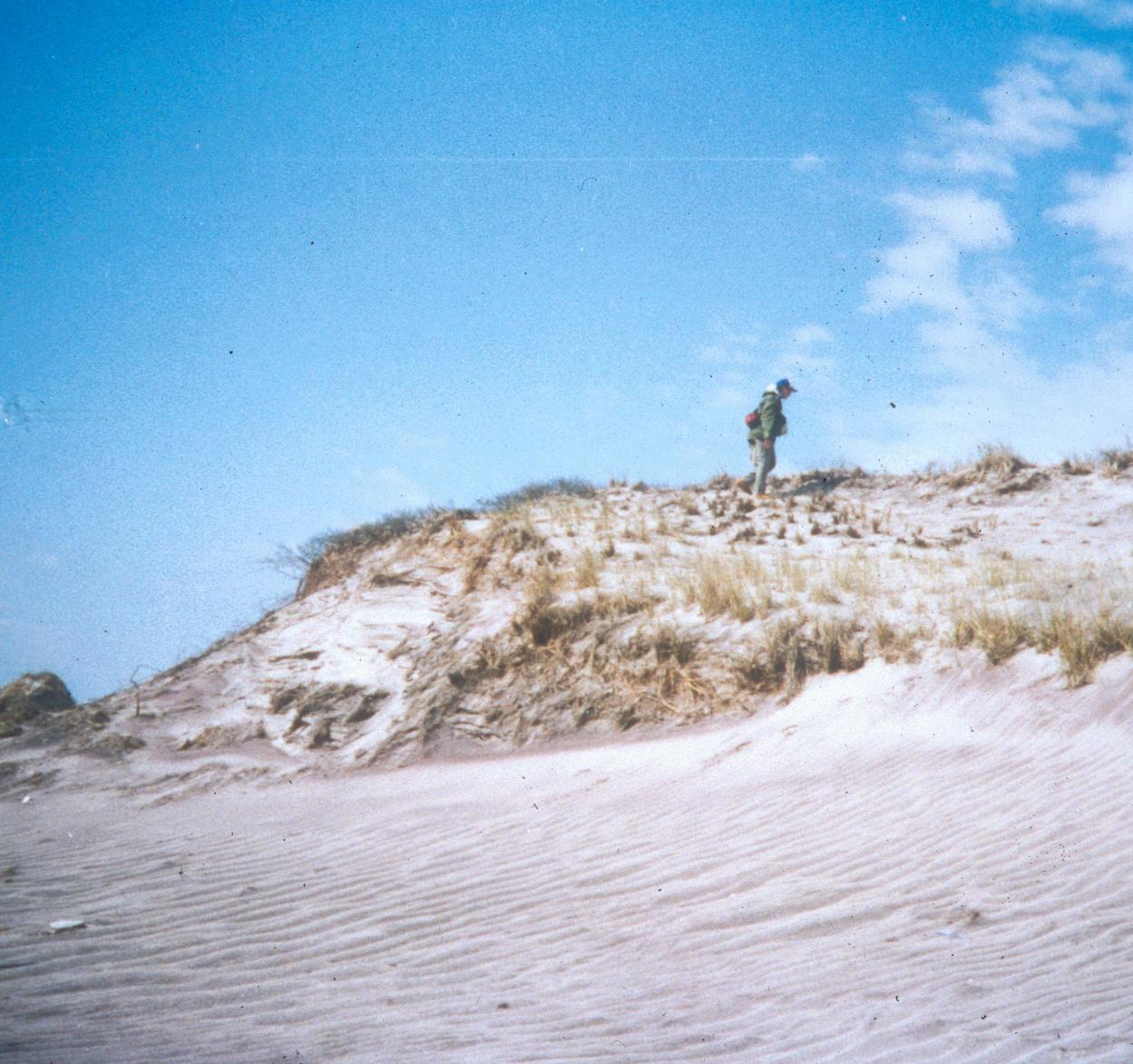
|
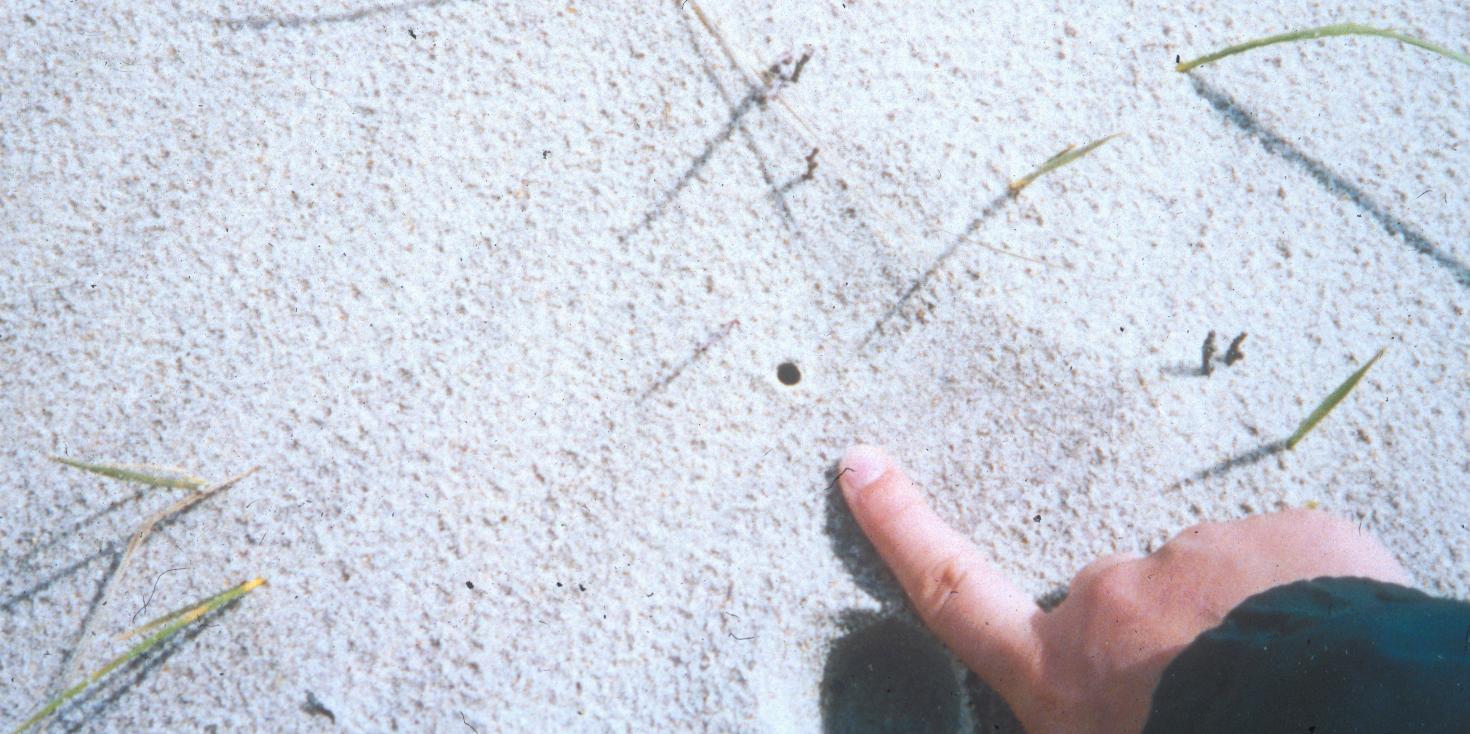
|
|
Dune collection
site on Long Island barriers
|
Geolycosa pikei burrow entrance
|
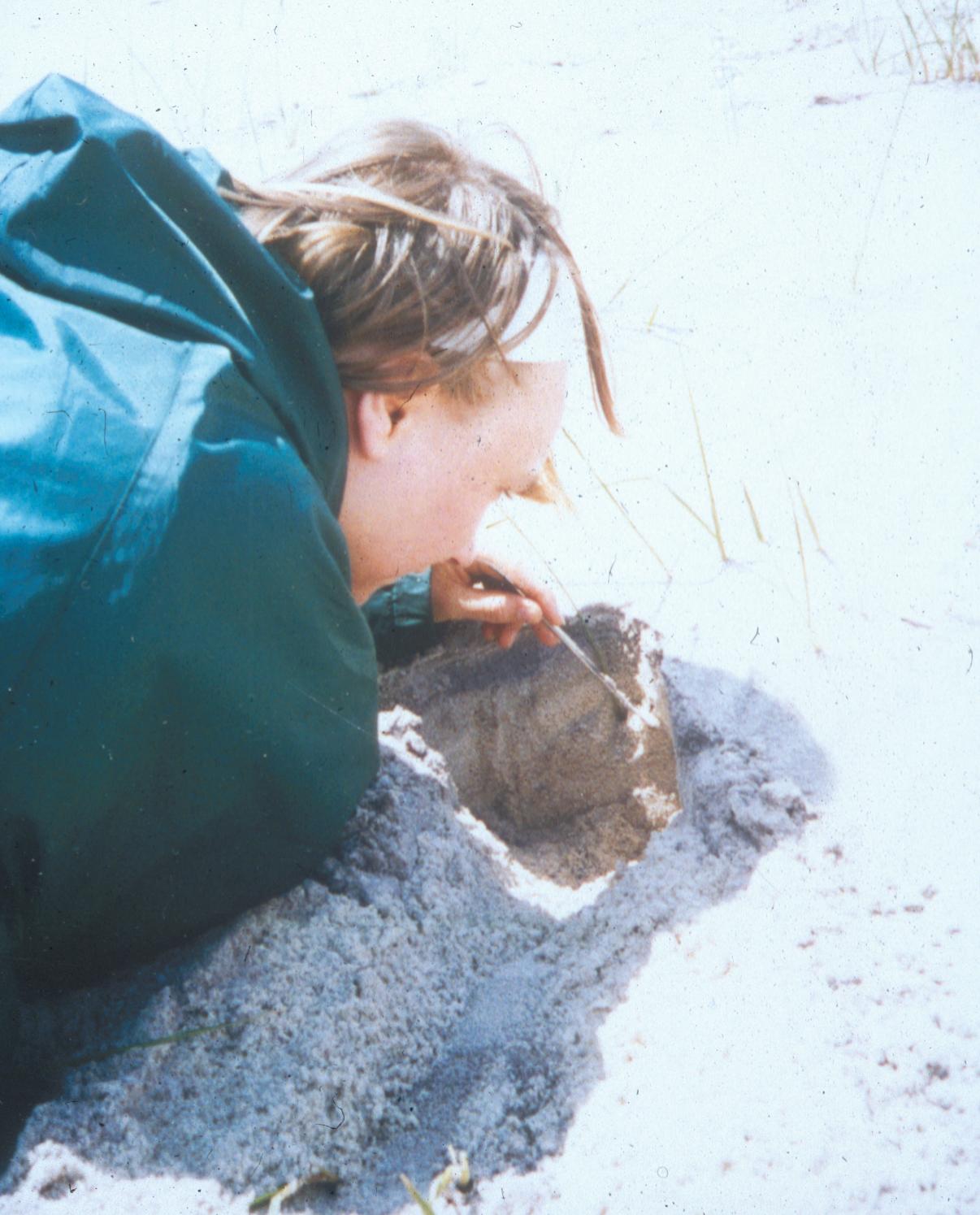
|
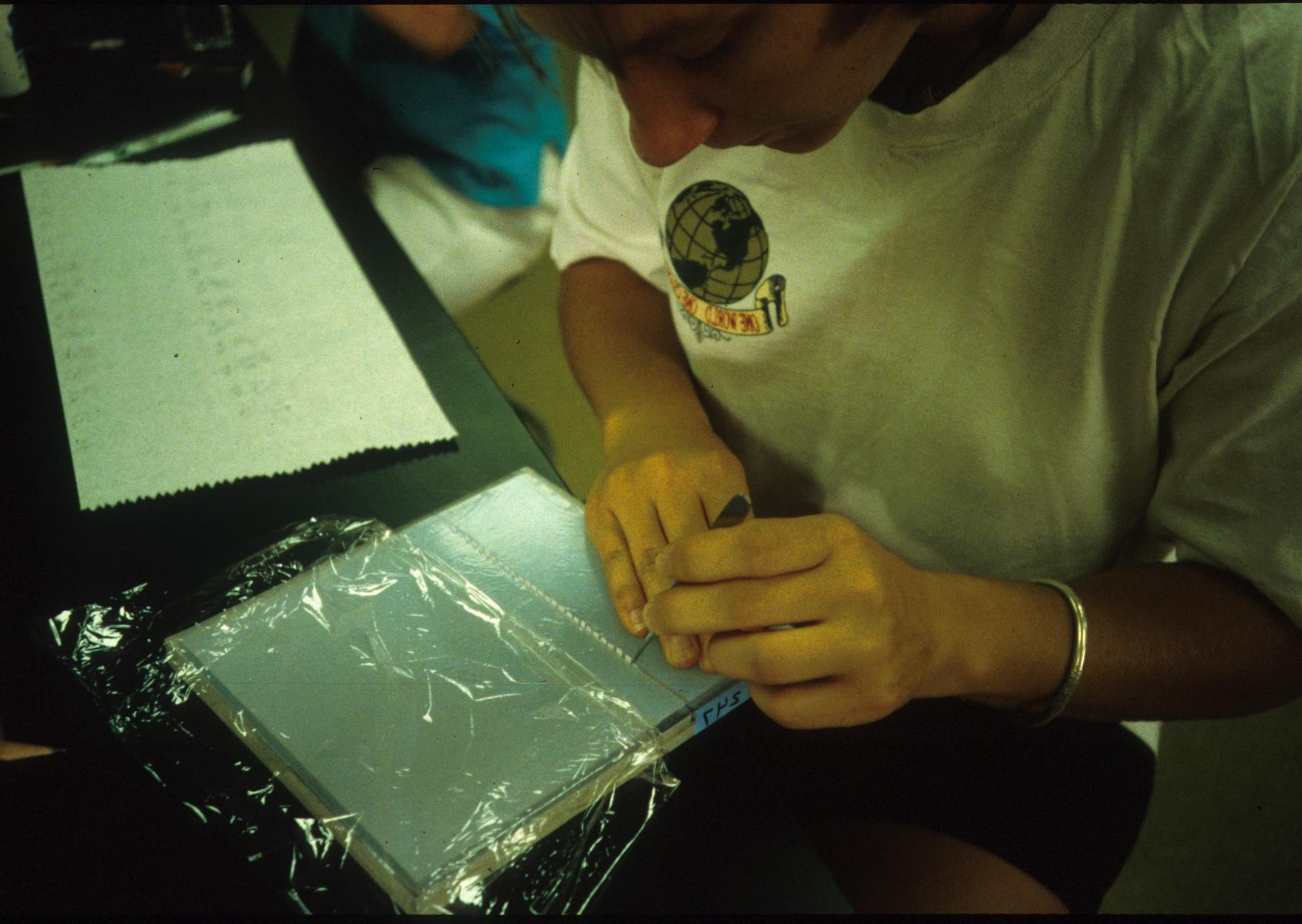
|
|
Excavating G.
pikei's burrow
|
Loading starch gels for allozyme electrophoresis
|

 MONKEYS
ON ISLANDS
MONKEYS
ON ISLANDS
THE BARBADOS VERVET MONKEY (CERCOPITHECUS AETHIOPS SABAEUS):
CHANGES IN POPULATION SIZE AND CROP DAMAGE 1980-1994
This paper investigates
changes in population size and crop damage for the vervet monkey (Cercopithecus
aethiops sabaeus) in Barbados over the period 1980-1994. In
both 1980 and 1994 data were obtained primarily through a survey of farmers
islandwide to obtain estimates of troop size and number of troops on agricultural
land. The farmers' estimates were independently assessed for reliability
by conducting counts
of numbers
of troops and troop size on a sub-sample of farms. Approximately
20% of the total land area in Barbados was surveyed and the results extrapolate
to the whole island. The results suggest that, despite the removal
of over 10,000 vervets through trapping and hunting over the 14-year period,
population abundance has increased marginally by about 4.5% from a population
size of about 14,190 in 1980 to a current
size of about
14,835. Over the same time period, the % of crops damaged by vervets
is estimated to have increased by almost 30%. The increase in crop
damage relative to the increase in vervet abundance may best be explained
by a decrease in the availability of crops to vervets, since substantial
amounts of agricultural land have been taken out of crop production
between 1980 and 1994.
Boulton, A. M., Horrocks, J. A., & Baulu,
J. 1996. The Barbados vervet monkey (Cercopithecus aethiops sabaeus
): Changes in population size and crop damage 1980-1994. International
Journal of Primatology 17: 831-844.
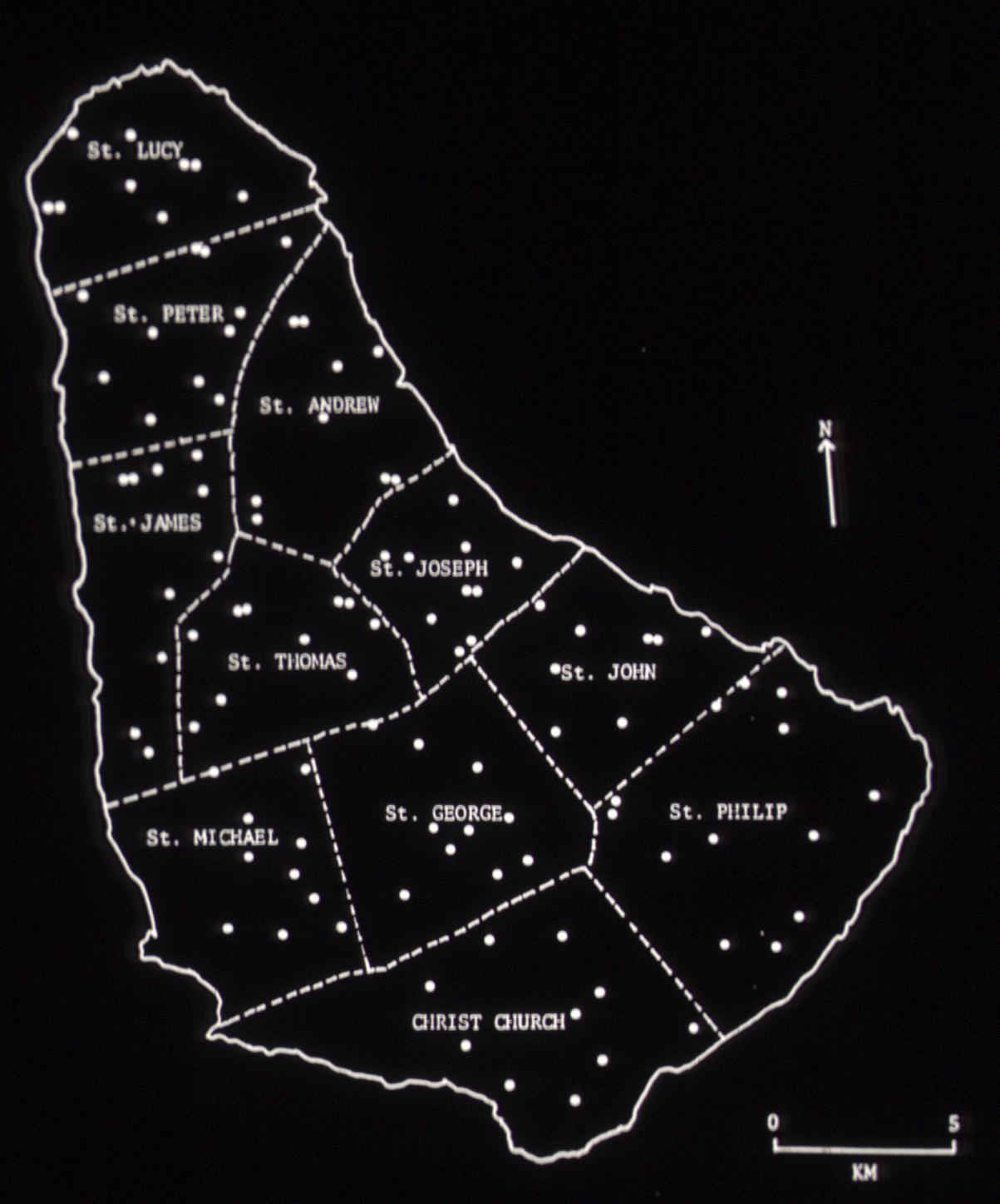
|

|
|
Map of Barbados
showing sampling locations
|
African Green Monkey (Cercopithecus aethiops saebeus
) |

 CURRICULUM
VITAE
CURRICULUM
VITAE
EDUCATION
| 2003 Ph.D. Ecology,
University of California, Davis, California |
| 1997-8 First year of Ph.D.
Biology, Vanderbilt University, Nashville, Tennessee |
| 1997 M. S. Biology,
Bucknell University, Lewisburg, Pennsylvania |
| 1994 B. S. Psychology,
Centre College, Danville, Kentucky |
PROFESSIONAL EXPERIENCE
2003-2005
POST-DOCTORAL FELLOW, Dept. of Biology, Villanova University, Villanova,
PA
|
| Fall 2001 INSTRUCTOR FOR
INTRO. TO ECOLOGY, Dept. of Env. Sci & Policy, University of California,
Davis, California |
| 1999- pres. WEB MASTER
for various web pages (URLs and samples available upon request) |
| 1999-2001 PUBLIC INFORMATION
OFFICER, Yolo-Solano Air Quality Management District, Davis, California |
| 1998-1999 TEACHING ASSISTANT,
Department of Env. Sci & Policy, University of California, Davis,
California |
| 1997-1998 TEACHING ASSISTANT,
Department of Biology, Vanderbilt University, Nashville, Tennessee |
| 1995-1997 TEACHING ASSISTANT,
Departments of Biology and Psychology, Bucknell University, Lewisburg,
Pennsylvania |
| 1991-1994 UNDERGRADUATE
TA, Departments of Psychobiology & Psych, Centre College, Danville,
Kentucky |
HONORS AND APPOINTMENTS
| Sigma Xi, 1996 |
| Phi Beta Kappa, 1994 |
| Psi Chi, Charter Member, 1994 |
| Phi Sigma Iota, President, 1993 |
| Omicron Delta Kappa, 1993 |
| Order of Omega, 1993 |
PROFESSIONAL SOCIETIES
| Phi Beta Kappa |
| Sigma Xi |
| Society for the Study of Evolution |
| Ecological Society of America |
SCHOLARSHIPS AND GRANTS
| STAR Fellowship, Environmental
Protection Agency - $66,000 plus tuition, 2000-2003 |
| Fulbright Scholarship, International
Institute of Education, 1994-1995 |
| UC Davis Jastro-Shields Grant
- $2000 for soil ecology research, 2001 |
| Research Fellowship - $2000
as part of a grant for the Consortium for Research at McLaughlin, Packard
Foundation, 2001-2002 |
| ARCS Grant - $5000, University
of California-Davis, 2000-2001 |
| Mildred Mathias Grant - $3000
for soil ecology research, NRS, 2000 |
| Kappa Kappa Gamma Foundation
Scholarship - $2000, 1999-2000 |
| Research Assistantship, University
of California-Davis, Winter 2000 |
| UC Davis Block Grant - $4000
(plus tuition), Spring 2000 |
| N.S.F. Research Training Grant
- $4300, Summer 2000 |
| UC Davis Jastro-Shields Grant
- $2000 for soil ecology research, 1999 |
| Graduate Teaching Assistantship,
University of California-Davis, 1998-1999 |
| Graduate Teaching Assistantship,
Vanderbilt University, 1997-1998 |
| Kappa Kappa Gamma Foundation
Academic Fellowship, 1996-1997 |
| Graduate Teaching Assistantship,
Bucknell University, 1995-1997 |
| Phi Sigma Iota Visa Scholarship,
Phi Sigma Iota, 1994 |
| James W. Overstreet Scholarship,
Centre College, 1993-1994 |
| John C. Young Scholar, Centre
College, 1993 |
| Colonel's Club Foundation, Centre
College, 1993 |
| Recognition Scholarship, Centre
College, 1990 |
GRADUATE TEACHING EXPERIENCE
| University of California,
Davis - Department of Environmental Science & Policy |
|
Fall 2001 - Instructor for
Introduction to Ecology
|
Winter
2000 - Island Biology, Seminar Organizer and Lecturer
|
|
Fall 1999 - TA Introduction to
Ecology Discussion Sections
|
|
Spring 1999 - TA Field Ecology
Laboratory
|
|
Winter 1999 - TA Introduction to
Environmental Policy
|
|
Fall 1998 - TA Introduction to
Ecology Discussion Sections
|
| Vanderbilt University
- Department of Biology |
|
Spring 1998 - TA Zoology Laboratory
|
|
Fall 1997 - TA Introductory Biology
Laboratory
|
| Bucknell University -
Department of Biology and Program in Animal Behavior/Department of Psychology |
|
Spring 1997 - TA General Biology
Laboratory
|
|
1995-6 - TA General Animal
Behavior Laboratory, Primate Behavior Laboratory, General Psychology
Lecture
|
UNDERGRADUATE TEACHING
EXPERIENCE
| Centre College - Departments
of Psychobiology and Psychology |
|
1992-4 - Biological Psychology
Laboratory, Experimental Psychobiology
|
|
1991-4 - Experimental Psychology,
General Psychology Laboratory
|
RESEARCH EXPERIENCE
| Present - Dissertation research
on population dynamics and island biogeography of myrmecofauna (ants)
on islands in the Sea of Cortez |
| Present - Field and laboratory
analysis of the effects harvester ants (Messor andrei) have on
the belowground foodwebs, soil chemistry, and plant communities |
Present
- Seed bank dynamics on desert islands
|
Present
- Stable isotope analysis of rodent and ant utilization curves
|
| 1997-1999 - Laboratory research
on the life history of and brood parasitism on the spider, Diguetia
mojavea |
|
1995-1997 - Field
and laboratory research on population genetics, systematics, and historical
biogeography of the spiders, Geolycosa pikei and Geolycosa
wrightii
|
| 1996 - Field and laboratory
research on queen-fighting behaviors in the honey bee, Apis mellifera |
| 1994-1995 - Field research on
population size and effects on Barbadian cash crops in the monkey,
Cercopithecus aethiops sabaeus |
| 1993-1994 - Zoo research
on juvenile social structure and play behavior in woolly monkeys, Lagothrix
lagotricha |
| 1993 - Zoo research on taste
aversion conditioning in Cuban crocodiles, Crocodylus rhombifer |
PAPERS PRESENTED AT MEETINGS
| 1998 - Ecological Society of
America, Baltimore, Maryland - A tale of two spiders: parasitoid-prey
interactions between salticids and Diguetia mojavea |
| 1997 - Society for the Study
of Evolution, Boulder, Colorado - Genetic structure of a coastal dune
spider (Geolycosa pikei) on Long Island, New York barrier islands |
| 1997 - Pennsylvania Academy
of Sciences, Malvern, Pennsylvania - A test of the stepping-stone model
in a coastal dune spider (Geolycosa pikei) on Long Island, New York
barrier islands |
| 1995 - American Society of Primatologists,
Scottsdale, Arizona - Reevaluating the Barbados vervet monkey population
and its role in crop damage |
| 1994 - Association for Women
in Psychology, Oakland, California - Physicians’ and the general public’s
AIDS risk assessment for sex-related activities |
PUBLICATIONS
| In press for 2002 - Boulton,
A. M. & Ward, P. S. Island biogeography of ants in the Sea of
Cortez. In Case & Cody, eds. Island Biogeography of the Sea
of Cortez, 2nd ed. University of California Press: Berkeley
& Los Angeles |
| 2002 - Boulton, A. M. &
Polis, G. A. Brood parasitism among spiders: interactions between salticids
and Diguetia mojavea. Ecology 83:282-287 |
| 1999 - Boulton, A. M. &
Polis, G. A. Natural history of the spider, Diguetia mojavea
(Araneae, Diguetidae), Journal of Arachnology 27:513-521. |
| 1997 - Boulton, A. M., Ramirez,
M. G. & Blair, C. Genetic structure of a coastal dune spider (Geolycosa
pikei ) on Long Island, New York barrier islands. Biological
Journal of the Linnean Society 60: 69-82. |
| 1996 - Boulton, A. M., Horrocks,
J. A., & Baulu, J. The Barbados vervet monkey (Cercopithecus aethiops
sabaeus ): Changes in population size and crop damage 1980-1994.
International Journal of Primatology 17: 831-844. |
| 1994 - Boulton, A. M.
Effects of masculine generic terms on elementary and college students’
self-esteem, self-perception, and attitudes. The Centre College John
C. Young Scholars Journal 5: 1-28. |
JOURNALS REFEREED
| Biotropica |
| Ecological Entomology |
| Ecology |
| Journal of Arachnology |
GUEST LECTURER
January 2000 - Loyola Marymount
College
1) Island biogeography and community importance of ants in the Sea
of Cortez
2) A tale of two spiders: parasitoid-prey interactions between salticids
and Diguetia mojavea |
| November 2000 - UC Davis (WFC
151) - Population Ecology and Analysis |
|
October 1997 - Centre
College
1) Genetic structure of a coastal dune spider (Geolycosa pikei)
on Long Island, New York barrier islands.
2) The Barbados vervet monkey (Cercopithecus aethiops sabaeus):
Changes in population size and crop damage 1980-1994
|

 WORKS
IN PROGRESS
WORKS
IN PROGRESS
Boulton AM, Jaffee BA, & Scow KM. Submitted to Applied Soil Ecology. Effects
of a harvester ant (Messor andrei ) on the diversity and abundance
of soil biota.
Boulton AM & Amberman KD. To be submitted to Ecology. A mechanistic
approach to the effects of a harvester ant (Messor andrei )
on the diversity and abundance of soil biota: A field experiment.
Boulton AM & Stapp PT. To be submitted to Journal of Arid Environments.
A comparison of ant and rodent feeding guilds on desert islands in the
Sea of Cortez using stable isotope analysis.
Lontoh DN, Boulton AM & Amberman KD. To be submitted to Journal of Arid Environments.
Seed bank analysis on desert islands in the Sea of Cortez.
Boulton AM. To be submitted to Ecography. Species richness
and abundance of ants on desert islands in the Sea of Cortez.

 RELATED
LINKS
RELATED
LINKS
![]()
![]()